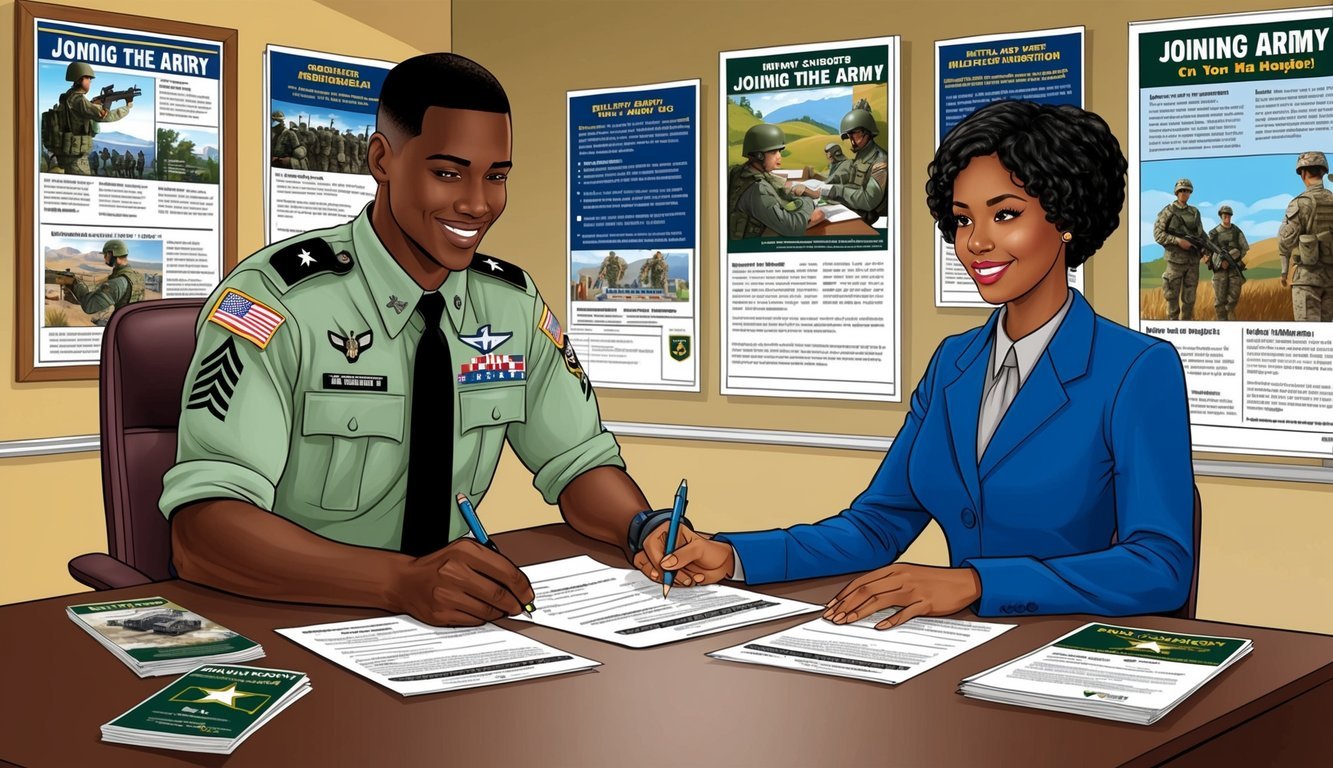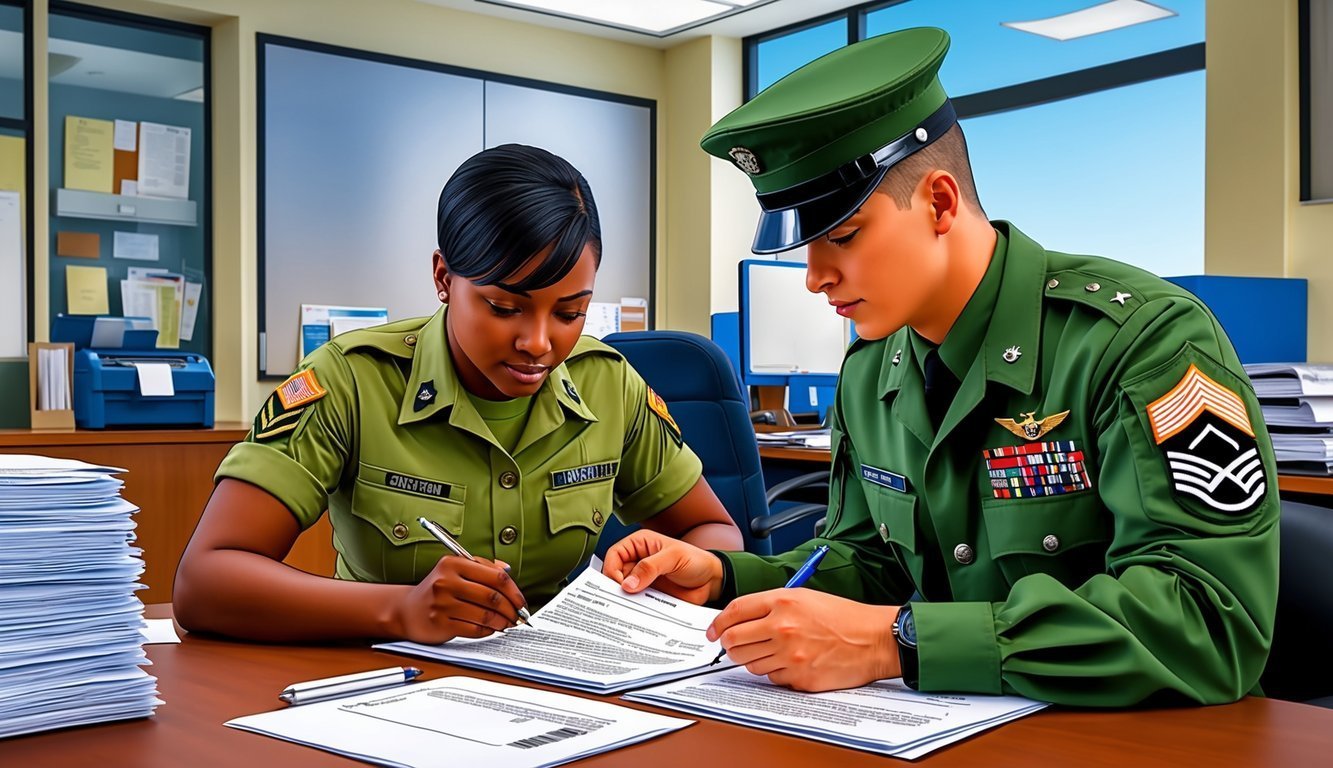Thinking about signing up for the U.S. Army? It’s a huge decision, and it’s definitely more than just slipping into a uniform.
You’re stepping into a whole new adventure and becoming part of a tight-knit team.

The journey to join the Army has a few important steps.
First, you’ll want to make sure you meet some basic requirements.
Next, you’ll have a chat with a recruiter who’ll help you see if the Army is the right fit for you. Here’s the scoop: To enlist, you need to be a U.S. citizen or a permanent resident, between 17 and 35 years old, and have a high school diploma or equivalent.
If you’re on the fence about it, take a look at the wide variety of roles in the Army.
There are tons of options out there.
You could dive into tech, drive trucks, or even practice medicine.
The Army website is a fantastic place to check out all the different jobs available.
Key Takeaways
- There are age and education requirements for joining the Army.
- Recruiters are here to help you through the sign-up process.
- The Army is packed with different job options.
Eligibility and Pre-Enlistment Steps

Getting into the Army is about meeting certain requirements and tackling a few initial steps.
This means checking your eligibility, looking into job options, and weighing important factors.
Check Your Eligibility
To join the Army, there are specific criteria to meet.
You need to be at least 17 but under 35 years old.
Oh, and U.S. citizenship or a Green Card is a must.
Don’t forget about education! A high school diploma is the bare minimum, though a GED might work too in some situations.
Physical fitness is a big deal; you’ll need to pass some medical exams and fitness tests.
Legal issues can play a role in whether or not you can enlist.
A clean record is ideal, but some minor offenses might be overlooked.
Just steer clear of any drug-related issues.
Explore Available Roles
The Army isn’t just about combat roles; there’s a world of choices available! Some popular fields include:
- Technology and cyber security
- Healthcare and medical services
- Engineering and construction
- Intelligence and communications
- Logistics and transportation
Every job has its unique requirements.
Some may need specific skills or education.
The Army Career Match tool is a handy way to find roles that might suit your interests and skills.
If you’re interested in a leadership role, check out ROTC programs that train college students to become Army officers after graduation.
Initial Considerations
Before you leap into Army life, there are a few things to think about.
It’s a major shift from civilian life.
Picture strict discipline, rigorous training, and a real commitment to teamwork.
Plus, you’ll need to figure out the base access signup process, which is all about security clearance and getting the green light to enter military facilities.
Familiarizing yourself with this stuff in advance can help smooth the transition.
- You might move around a lot.
- Following orders and keeping to a strict schedule is part of the deal.
- Expect to be away from family for extended periods.
- There could be dangerous situations to face.
But hey, the perks are pretty awesome! You’ll get free healthcare, housing allowances, and help with college tuition.
Plus, the training and leadership skills you gain can be invaluable later on.
It’s a good idea to chat with current or former soldiers—they’ve got the insider scoop.
And don’t overlook family support; the Army journey touches everyone in the family, not just the soldier.
The Enlistment Process
Joining the Army is all about following a set process.
You’ll need to complete testing, interviews, physical assessments, and paperwork before officially enlisting.
Taking the ASVAB
The Armed Services Vocational Aptitude Battery (ASVAB) is a must for anyone looking to enlist.
It measures your skills in various areas.
Here are some quick ASVAB facts:
- It has 9 sections covering math, science, and language.
- The whole thing takes about 3 hours.
- You can take it at schools or military processing stations.
- Your scores are valid for 2 years.
Your AFQT score from the ASVAB is key to determining if you qualify for the Army.
The better you do, the more job options and potential enlistment bonuses you may get.
Meet With a Recruiter
Your next step is to meet with an Army recruiter.
These folks are here to guide you through the enlistment process.
They’ll have answers to your questions and info about what Army life is like.
What can you expect when you meet a recruiter?
- A discussion about your career goals.
- An overview of Army benefits.
- Details about enlistment requirements.
- Info on available job opportunities.
Recruiters can also help you take the ASVAB and schedule your physical exams.
Come prepared with questions about Army life and the roles you’re interested in.
Army Physical Fitness Standards
To join the Army, you’ll need to meet specific fitness criteria that ensure you’re ready for the physical demands of military service.
The basic fitness test includes:
- Timed push-ups.
- Timed sit-ups.
- A timed 2-mile run.
Keep in mind that standards vary by age and gender.
It’s a good idea to start training well in advance to boost your performance with regular cardio and strength exercises.
Medical Examination
A thorough medical exam is part of the enlistment process.
This checks if you’re healthy enough for military service.
The exam typically includes:
- Height and weight measurements.
- Vision and hearing tests.
- Blood and urine samples.
- A review of your medical history.
Some medical conditions might disqualify you, while others may need waivers, so it’s important, to be honest about your health history.
Selecting Your Army Role
With the Army offering a wide array of career paths, picking the right job is crucial.
When you’re thinking about an Army job, consider:
- Your ASVAB scores.
- Your personal interests.
- Available openings.
- How long the training will take.
Popular Army careers include:
- Infantry.
- Medical specialists.
- Intelligence analysts.
- Mechanics.
Recruiters are great at matching applicants with jobs that suit their skills and ambitions.
Plus, the Army Career Match tool is another handy resource to suggest jobs based on what you like.
Finalizing Enlistment
Once you’ve chosen your path, it’s time to make it official by signing the enlistment contract.
This is when you put your commitment on paper.
Here’s what you need to know about finalizing enlistment:
- Carefully review and sign the enlistment contract.
- Take the Oath of Enlistment.
- Get your ship date for basic training.
When it comes to enlistment options, you can choose between active duty, Reserve, or National Guard.
Each has its own commitment and perks, so think carefully about which one suits your goals best before you sign.
After you finalize your enlistment, it’s time to prepare for basic training—the beginning of your Army journey!
Frequently Asked Questions
Joining the Army is all about meeting specific requirements and following a set process.
Keep in mind that steps may vary based on age, citizenship status, and gender.
What are the basic requirements to enlist in the Military?
To join the Army, you must be at least 17 years old and a U.S. citizen or permanent resident.
A high school diploma or equivalent is necessary too.
You also need to be in good physical shape and pass the Army’s height and weight standards.
Can you join the Army if you’re over the age of 45?
Typically, the maximum age for new recruits is 35, but in some rare cases, age waivers can be granted—often for individuals with specialized skills or if recruitment needs are high.
What’s the process for a foreigner to apply to the U.S. Army?
If you’re a non-U.S. citizen and have a valid Green Card, you can join the Army.
The process is quite similar to what U.S. citizens go through, though you might have extra background checks and security clearances.
How do women sign up for the Army?
Women can enlist in the Army just like men.
You’ll need to meet the same basic requirements and go through the same enlistment steps.
It’s worth noting that all combat roles are open to women now, so women can serve in any job they qualify for, including infantry and special forces.
What’s the timeline for joining the Army once you’ve applied?
The timeline can vary a lot depending on your personal situation.
Usually, it takes a few months from your first meeting with a recruiter to starting basic training.
After signing a contract, you’ll often have some time to get ready before heading off to basic training.
Can I enlist in the Army online, or do I need to visit a recruiter?
You can kick things off online by filling out some forms and gathering information.
But you’ll need to meet with a recruiter in person to wrap up the enlistment process.
A face-to-face meeting helps the recruiter determine your eligibility and gives you a chance to voice any questions or concerns you may have about Army life and the opportunities available.

